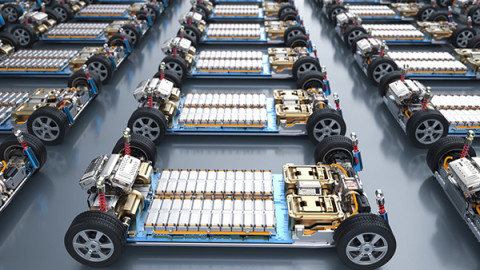Researchers create a new material that doubles the performance of lithium batteries, key for electric vehicles

An international research team with participation of the Material Science Institute of Madrid (ICMM-CSIC), under the Ministry of Science, Innovation, and Universities (MCIU), along with researchers from the United Arab Emirates and India, has discovered and developed a new material that doubles the performance of commercial lithium-ion batteries. The finding, published in Angewandte Chemie International Edition, could be crucial for the industrial advancement of electric vehicles and other electronic devices.
Lithium-ion batteries are the most widely used rechargeable batteries today. However, they still face several challenges, particularly regarding their performance, which is where this research could mark a turning point. "Graphite has been the predominant material in lithium-ion battery anodes due to its stability and relatively low cost, but its storage capacity is limited," explains José Ignacio Martínez, ICMM-CSIC researcher and one of the study’s authors.
They needed to develop a material "that has better efficiency than commercial graphite while maintaining its characteristics related to economic scalability and environmental safety," adds Felipe Gándara, also an ICMM-CSIC researcher and author of the work. To achieve this, the scientists turned to MOFs, a material that combines organic molecules with metals and features "highly versatile" porous structures that allow for lithium-ion storage. These materials had not been used previously because they presented "relatively poor performance, chemical instability", and difficulties in large-scale production.
These two problems were solved by combining the materials: the team created a new type of metal-organic material with iron and salicylaldehyde (Fe-Tp), and once they demonstrated "remarkable performance as an anode material in lithium batteries," they incorporated it into graphite. This approach retains the MOF’s properties (storage capacity), avoids its issues (stability), and, additionally, doubles the storage capacity of graphite, thereby improving battery performance.
 This MOF features pores of different sizes (hierarchical porosity), allowing lithium ions to move easily during battery cycles. Moreover, "after 500 charge and discharge cycles at a constant rate, the material retained 89% of its cyclic stability, highlighting its durability and potential for long-term applications," the researchers emphasize. They further note that this improvement positions their material "as an excellent enhancer of commercial anode material, suggesting it could easily integrate into current technologies without the need for total graphite replacement."
This MOF features pores of different sizes (hierarchical porosity), allowing lithium ions to move easily during battery cycles. Moreover, "after 500 charge and discharge cycles at a constant rate, the material retained 89% of its cyclic stability, highlighting its durability and potential for long-term applications," the researchers emphasize. They further note that this improvement positions their material "as an excellent enhancer of commercial anode material, suggesting it could easily integrate into current technologies without the need for total graphite replacement."
Implications for Technological Development
This discovery has significant implications for the future development of higher-performance lithium-ion batteries: "The ability to significantly enhance lithium storage capacity using an affordable and scalable additive like Fe-Tp opens the door to more efficient batteries that can last longer and offer greater range in devices and electric vehicles," says Martínez.
"Additionally, the environmental safety of this new material and its scalability for large-scale production represents a major advancement for energy storage industries seeking sustainable and economically viable solutions," Gándara adds. Both researchers suggest that this discovery advances the development of a new generation of lithium-ion batteries that "will not only be more powerful but also safer and more accessible, which could radically change the global energy storage market in the coming years," they conclude.
Reference:
Safa Gaber, Abdul Khayum Mohammed, Bharathkumar H. Javaregowda, José Ignacio Martínez, Pilar Pena Sánchez, Felipe Gándara, Kothandam Krishnamoorthy, Dinesh Shetty: MOFite: A High-Density Lithiophilic and Scalable Metal–Organic Framework Anode for Rechargeable Lithium-Ion Battery. *Angewandte Chemie International Edition*, DOI: 10.1002/anie.202409256
Instituto de Ciencia de Materiales de Madrid (ICMM)
Sor Juana Ines de la Cruz, 3
Cantoblanco, 28049
Madrid, España
Telephone: (+34) 91 334 90 00
Email: @email
Communication Office: @email

Acknowledge the Severo Ochoa Centres of Excellence program through Grant CEX2024-001445-S/ financiado por MICIU/AEI / 10.13039/501100011033

Contacto | Accesibilidad | Aviso legal | Política de Cookies | Protección de datos